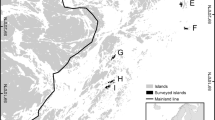Summary
Using 94 data sets from across the globe, we explored patterns of mean community species richness, landscape species richness, mean similarity among communities and mosaic diversity. Climate affected community species richness primarily through productivity while other climatic factors were secondary. Climatic equability affected species richness only in temperate regions where richness was greatest at high levels of temperature variability and low levels of precipitation variability. Landscape species richness correlated positively with community species richness. A global gradient in mean similarity existed but was uncorrelated with community species richness. Mean similarity was least and mosaic diversity was greatest between 25 and 30° latitude. The most diverse landscapes (low mean similarity) correlated with warm temperatures, high elevations, large areas and large seasonal temperature fluctuations. The most complex landscapes (high mosaic diversity) correlated with large areas, high productivity and warm winters. We compared diversity measures among continents and found only one significant difference: Australian landscapes have greater mosaic diversity than African landscapes. Based on our analyses we propose two hypotheses: (1) for plants, biotic interactions are more important in structuring landscapes in warmer climates and (2) longer isolated landscapes have more clearly differentiated ecological subunits.
Similar content being viewed by others
References
Adams, J.M. and Woodward, F.I. (1989) Patterns in tree species richness as a test of the glacial extinction hypothesis.Nature 339, 699–701.
Barry, R.G. (1981)Mountain Weather and Climate. Methuen, New York.
Braun, E.L. (1950)Deciduous Forests of Eastern North America. The Blakiston Co., Philadelphia.
Connell, J.H. and Orias, E. (1964) The ecological regulation of species diversity.Am. Nat. 98, 399–414.
Currie, D.J. (1991) Energy and large-scale patterns of animal- and plant-species richness.Am. Nat. 137, 27–49.
Currie, D.J. and Paquin, V. (1987) Large-scale biogeographical patterns of species richness of trees.Nature 329, 326–7.
Gentry, A.H. (1982) Patterns of neotropical plant species diversity.Evol. Biol. 15, 1–84.
Jaccard, P. (1901) Distribution de la flore alpine dans le Bassin des Dranes et dans quelques regions voisines.Bull. Soc. Vaud. Sci. Nat. 37, 241–72.
Lauscher, F. (1976) Welweite Typen der Hohenabhangigkeit des Niederschlags.Wetter u. Leben 28, 80–90.
Pianka, E.R. (1966) Latitudinal gradients in species diversity: a review of concepts.Am. Nat. 100, 65–75.
Preston, F.W. (1962) The canonical distribution of commonness and rarity.Ecology 43, 185–215.
Rudloff, W. (1981)World-Climates, Wissenschaflicht Verlagsgesellschaft, Stuttgart.
Sanders, H.L. (1968) Marine benthic diversity: a comparative study.Am. Nat. 102, 243–82.
Scheiner, S.M. (1990) Affinity analysis: effects of sampling.Vegetatio 86, 175–81.
Scheiner, S.M. (1992) Measuring pattern diversity.Ecology 73, 1860–7.
Scheiner, S.M. and Istock, C.A. (1994) Species enrichment in a transitional landscape, northern lower Michigan;Can. J. Bot. 72 (in press).
Shmida, A. and Wilson, M.V. (1985) Biological determinants of species diversity.J. Biogeogr. 12, 1–20.
Smith, T. and Huston, M. (1989) A theory of the spatial and temporal dynamics of plant communities.Vegetatio 83, 49–69.
Stephenson, N.L. (1990) Climatic control of vegetation distribution: the role of the water balance.Am. Nat. 135, 649–70.
Stevens, G.C. (1989) The latitudinal gradient in geographical range: how so many species coexist in the tropics.Am. Nat. 133, 240–56.
Thornthwaite, C.W. (1948) An approach toward a national classification of climate.Geograph. Rev. 38, 55–94.
US West Optical Publishing, Inc. (1989)The Climate Disk. US West Optical Publishing, Washington, DC.
Wallace, A.R. (1878)Tropical Nature and Other Essays. Macmillan, New York.
WeatherDisc Associates (1989)World Weather Disk. WeatherDisc Associates, Denver.
Whittaker, R.H. (1972) Evolution and measurement of species diversity.Taxon 21, 213–51.
Whittaker, R.H. (1977) Evolution of species diversity in land communities. InEvolutionary Biology (M.K. Hecht, W.C. Steere and B. Wallace, eds), pp. 1–67. Plenum, New York.
Whittaker, R.H. and Likens, G.E. (1973) Carbon in the biota. InCarbon and the Biosphere (G.M. Woodwell and E.V. Pecan, eds), pp. 281–302. National Technical Information Service, Springfield, VA.
Wilkinson, L. (1988)SYSTAT: The System for Statistics. SYSTAT, Inc., Evanston, IL.
Woodward, F.I. (1987)Climate and Plant Distribution. Cambridge University Press, Cambridge, UK.
Author information
Authors and Affiliations
Rights and permissions
About this article
Cite this article
Scheiner, S.M., Rey-Benayas, J.M. Global patterns of plant diversity. Evol Ecol 8, 331–347 (1994). https://doi.org/10.1007/BF01238186
Issue Date:
DOI: https://doi.org/10.1007/BF01238186




